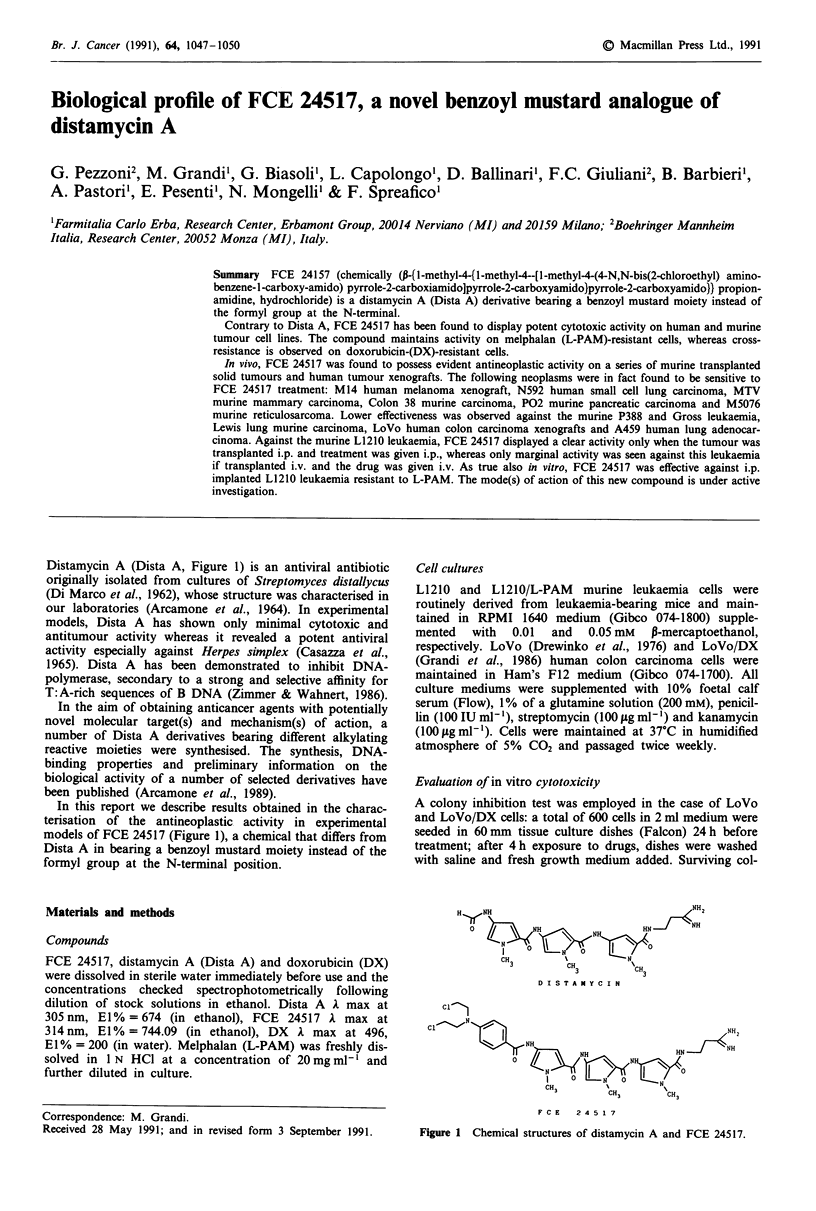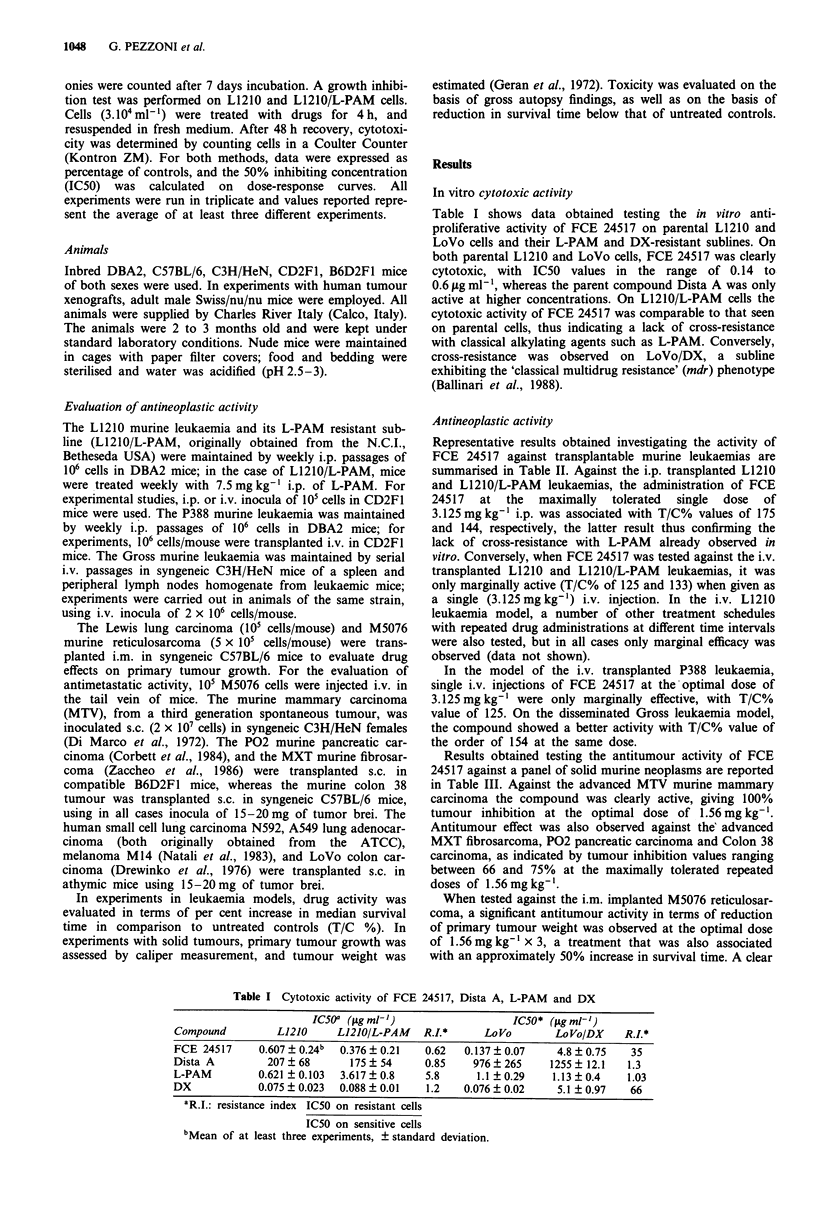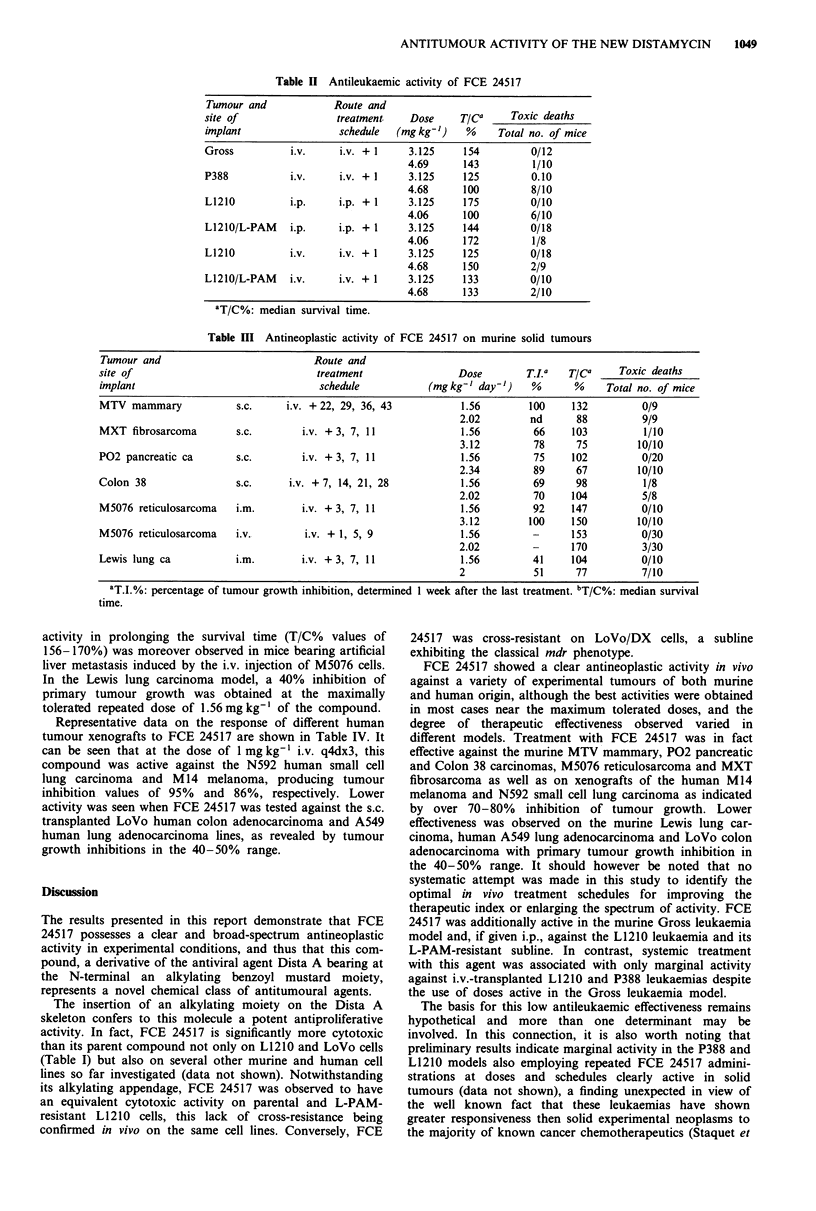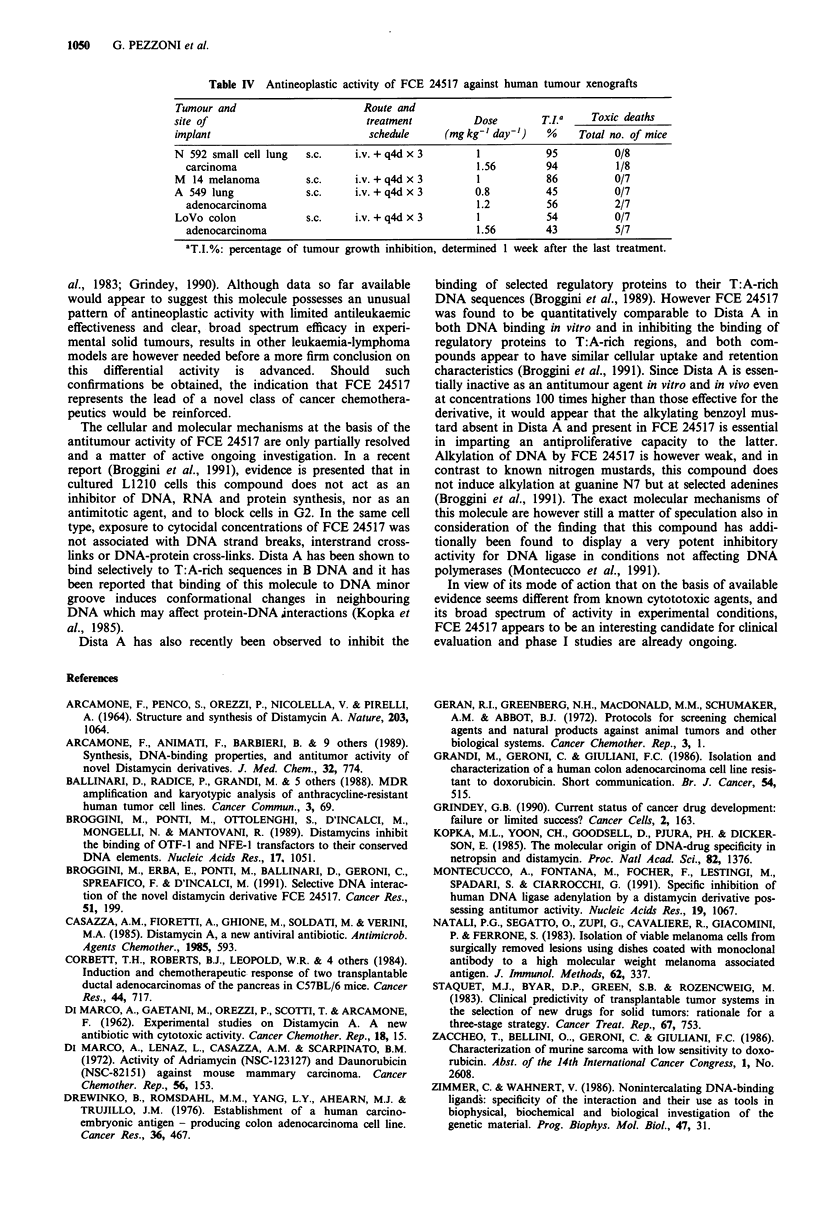Abstract
FCE 24157 (chemically (beta-[1-methyl-4-(1-methyl-4--[1-methyl-4-(4-N,N- bis(2-chloroethyl) amino-benzene-1-carboxy-amido) pyrrole-2-carboxiamido]pyrrole-2-carboxyamido)pyrrole-2-c arboxyamido]) propionamidine, hydrochloride) is a distamycin A (Dista A) derivative bearing a benzoyl mustard moiety instead of the formyl group at the N-terminal. Contrary to Dista A, FCE 24517 has been found to display potent cytotoxic activity on human and murine tumour cell lines. The compound maintains activity on melphalan (L-PAM)-resistant cells, whereas cross-resistance is observed on doxorubicin-(DX)-resistant cells. In vivo, FCE 24517 was found to possess evident antineoplastic activity on a series of murine transplanted solid tumours and human tumour xenografts. The following neoplasms were in fact found to be sensitive to FCE 24517 treatment: M14 human melanoma xenograft, N592 human small cell lung carcinoma, MTV murine mammary carcinoma, Colon 38 murine carcinoma, PO2 murine pancreatic carcinoma and M5076 murine reticulosarcoma. Lower effectiveness was observed against the murine P388 and Gross leukaemia, Lewis lung murine carcinoma, LoVo human colon carcinoma xenografts and A459 human lung adenocarcinoma. Against the murine L1210 leukaemia, FCE 24517 displayed a clear activity only when the tumour was transplanted i.p. and treatment was given i.p., whereas only marginal activity was seen against this leukaemia if transplanted i.v. and the drug was given i.v. As true also in vitro, FCE 24517 was effective against i.p. implanted L1210 leukaemia resistant to L-PAM. The mode(s) of action of this new compound is under active investigation.
Full text
PDF



Selected References
These references are in PubMed. This may not be the complete list of references from this article.
- ARCAMONE F., PENCO S., OREZZI P., NICOLELLA V., PIRELLI A. STRUCTURE AND SYNTHESIS OF DISTAMYCIN A. Nature. 1964 Sep 5;203:1064–1065. doi: 10.1038/2031064a0. [DOI] [PubMed] [Google Scholar]
- Arcamone F. M., Animati F., Barbieri B., Configliacchi E., D'Alessio R., Geroni C., Giuliani F. C., Lazzari E., Menozzi M., Mongelli N. Synthesis, DNA-binding properties, and antitumor activity of novel distamycin derivatives. J Med Chem. 1989 Apr;32(4):774–778. doi: 10.1021/jm00124a008. [DOI] [PubMed] [Google Scholar]
- Broggini M., Erba E., Ponti M., Ballinari D., Geroni C., Spreafico F., D'Incalci M. Selective DNA interaction of the novel distamycin derivative FCE 24517. Cancer Res. 1991 Jan 1;51(1):199–204. [PubMed] [Google Scholar]
- Broggini M., Ponti M., Ottolenghi S., D'Incalci M., Mongelli N., Mantovani R. Distamycins inhibit the binding of OTF-1 and NFE-1 transfactors to their conserved DNA elements. Nucleic Acids Res. 1989 Feb 11;17(3):1051–1059. doi: 10.1093/nar/17.3.1051. [DOI] [PMC free article] [PubMed] [Google Scholar]
- Corbett T. H., Roberts B. J., Leopold W. R., Peckham J. C., Wilkoff L. J., Griswold D. P., Jr, Schabel F. M., Jr Induction and chemotherapeutic response of two transplantable ductal adenocarcinomas of the pancreas in C57BL/6 mice. Cancer Res. 1984 Feb;44(2):717–726. [PubMed] [Google Scholar]
- DIMARCO A., GAETANI M., OREZZI P., SCOTTIT, ARCAMONE F. Experimental studies on distamycin A--a new antibiotic with cytotoxic activity. Cancer Chemother Rep. 1962 May;18:15–19. [PubMed] [Google Scholar]
- Di Marco A., Lenaz L., Casazza A. M., Scarpinato B. M. Activity of adriamycin (NSC-123127) and daunomycin (NSC-82151) against mouse mammary carcinoma. Cancer Chemother Rep. 1972 Apr;56(2):153–161. [PubMed] [Google Scholar]
- Drewinko B., Romsdahl M. M., Yang L. Y., Ahearn M. J., Trujillo J. M. Establishment of a human carcinoembryonic antigen-producing colon adenocarcinoma cell line. Cancer Res. 1976 Feb;36(2 Pt 1):467–475. [PubMed] [Google Scholar]
- Grandi M., Geroni C., Giuliani F. C. Isolation and characterization of a human colon adenocarcinoma cell line resistant to doxorubicin. Br J Cancer. 1986 Sep;54(3):515–518. doi: 10.1038/bjc.1986.206. [DOI] [PMC free article] [PubMed] [Google Scholar]
- Grindey G. B. Current status of cancer drug development: failure or limited success? Cancer Cells. 1990 Jun;2(6):163–171. [PubMed] [Google Scholar]
- Kopka M. L., Yoon C., Goodsell D., Pjura P., Dickerson R. E. The molecular origin of DNA-drug specificity in netropsin and distamycin. Proc Natl Acad Sci U S A. 1985 Mar;82(5):1376–1380. doi: 10.1073/pnas.82.5.1376. [DOI] [PMC free article] [PubMed] [Google Scholar]
- Montecucco A., Fontana M., Focher F., Lestingi M., Spadari S., Ciarrocchi G. Specific inhibition of human DNA ligase adenylation by a distamycin derivative possessing antitumor activity. Nucleic Acids Res. 1991 Mar 11;19(5):1067–1072. doi: 10.1093/nar/19.5.1067. [DOI] [PMC free article] [PubMed] [Google Scholar]
- Natali P. G., Segatto O., Zupi G., Cavaliere R., Giacomini P., Ferrone S. Isolation of viable melanoma cells from surgically removed lesions using dishes coated with monoclonal antibody to a high molecular weight melanoma associated antigen. J Immunol Methods. 1983 Sep 16;62(3):337–346. doi: 10.1016/0022-1759(83)90178-3. [DOI] [PubMed] [Google Scholar]
- Staquet M. J., Byar D. P., Green S. B., Rozencweig M. Clinical predictivity of transplantable tumor systems in the selection of new drugs for solid tumors: rationale for a three-stage strategy. Cancer Treat Rep. 1983 Sep;67(9):753–765. [PubMed] [Google Scholar]
- Zimmer C., Wähnert U. Nonintercalating DNA-binding ligands: specificity of the interaction and their use as tools in biophysical, biochemical and biological investigations of the genetic material. Prog Biophys Mol Biol. 1986;47(1):31–112. doi: 10.1016/0079-6107(86)90005-2. [DOI] [PubMed] [Google Scholar]


